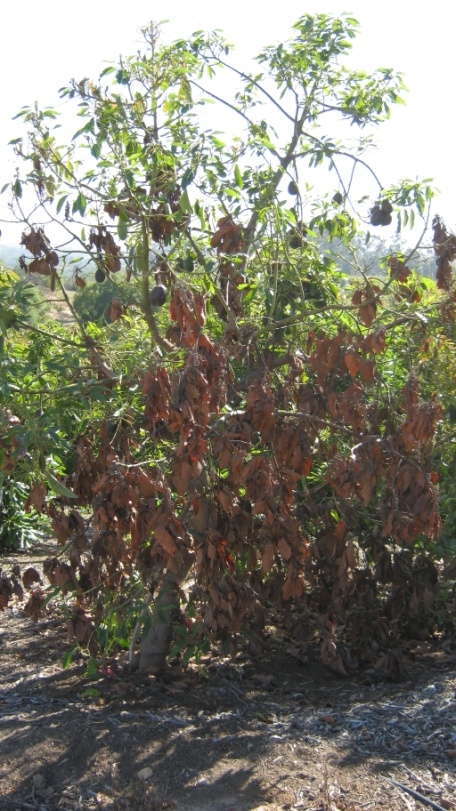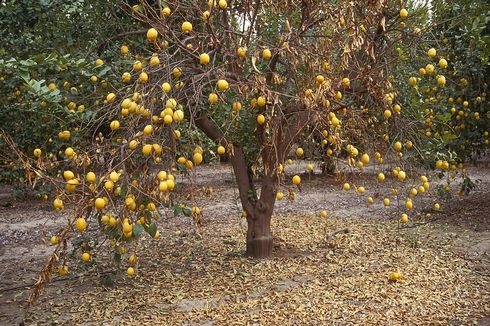- Author: Ben Faber
It's that time of year to see some drama in avocado orchards. Once healthy-looking trees can suddenly turn brown in a weekend and all the surrounding trees still look fine. And it can be quite common in some years along the coast. The winter weather will have mild, cool even rainy days and then suddenly there's one of those 97 deg days and the tree goes down,
The entire tree or only one or several branches wilt suddenly when affected by Verticillium wilt. Leaves turn brown and die, but the dead leaves usually remain on the tree for several months. Brown to gray-brown streaks are visible in the xylem of the branches or roots when the bark is removed. Sometimes the streaking is visible in the branches, but often it is found at the base of the trunk.
Trees with Verticillium wilt often send out new, vigorous shoots within a few months after the initial wilting. If well cared for, affected trees often recover completely with no reoccurrence of the disease. However, not all trees survive an infection and disease symptoms sometimes reoccur after an apparent recovery.
The fungal pathogen Verticillium dahliae infects many hosts, including various berry and flower crops, cotton, eggplant, olive, pepper, stone fruit trees, strawberry, and tomato. Verticillium wilt is present throughout the state but is less common in avocado than root rot and canker diseases. Verticillium dahliae persists for years as microsclerotia in soil. Microsclerotia spread in infested organic matter and soil that is moved. The fungus infects through feeder roots, and then moves up in the water-conducting xylem system, restricting or preventing water movement to foliage from the roots.
No known methods are effective in curing infected trees. Trees often recover completely and display no further symptoms, even though they are still infected. After dieback ceases and new growth begins, prune off dead branches. Provide optimal irrigation and modest fertilization to promote new growth. If a tree dies from Verticillium, remove it. But give it a chance, there's a good chance it will recover.
In areas where V. dahliae is known to occur, plant Mexican rootstocks instead of the more Verticillium-susceptible Guatemalan rootstocks. Do not plant avocado on land where crops susceptible to Verticillium wilt have previously grown. Do not interplant avocado with other hosts of Verticillium, which are listed in publications such as Plants Resistant or Susceptible to Verticillium Wilt (PDF). Even if they have recovered, do not use trees infected with Verticillium wilt as a source of budwood or seed.

- Author: Ben Faber
The destruction after a fire can be pretty gruesome and sad. Many times, though the fire moves through the orchard so fast that, even though the canopy has turned brown, there is a good chance the trees can come back. It all depends on how much damage has been done to the trunk. If the fire has substantially damaged the base of the trunk, it is unlikely to come back, even if the canopy is still green. That is the saddest thing, because you think you've dodged the bullet, but if the trunk is too damage, the canopy collapses gradually over a few weeks. However, the canopy may look a goner, but if the trunk is still intact, the tree will come back and may still be as productive as before.
The thing to look for at the base of the trunk is the discoloration. If it's black, it's probably not coming back. However, it can come back if after a few weeks you don't see the pencil-sized cankers that indicate that the sap has bubbled to the surface (see photo 1 below). If after a few weeks, the trunk is still clear of those bubbles (photo 2), even though the canopy looks gone, it is quite likely to come back.
It's also possible that the trunk may be damage in just one part of the trunk and not on the rest. In this case, it can also come back. The problem with these ones, is that they may come back and given enough time will be good trees again. But if they haven't recovered enough and there's a sudden heat spell, they may go down suddenly as if they had been burned again. That's the way they will look, like they have been burned again. Given enough time, though the avocado will grow from good areas to cover the poor areas and the tree may be productive again.
Avocados are amazing in their ability to recover. Eucalyptus can do it. But you singe the trunk of a lemon, and good-bye lemon.
Fire Information:
http://ceventura.ucanr.edu/Agricultural_Threats/Fire_Information/
Photo 1 and 2.


- Author: Ben Faber
This has been a hot time. Look for irrigation problems, but also look for other weather related problems. This is possibly the most shocking.
If you see your citrus tree suddenly collapse. It happens on a weekend or in a few days, and it has suddenly turned hot with a Santa Ana or Sundowner, it is quite likely "Dry Root Rot". This is a situation where the water conducting tissues, the xylem, have been clogged by fungi and when a sudden demand for water comes from the weather, the tree collapses because it can not support the movement of enough water to satisfy that demand. It is more common along the coast than the Valleyk, but it does occur there, as well.
It starts with some type of wound to the crown roots or stem - gophers or field mice nibbling away at the roots or crown. Or damage from weed whipping or some sort of mechanical damage. This allows entry of the Fusarium fungus that causes the xylem clogging. You can usually see the damaged tissue just below the bark, near the base of the tree. The damage has usually occurred several years prior and takes awhile for the fungus to do its clogging. There's no know cure for this situation. Cut the tree out. It's not particularly contagious as far as we know. The fungus is cosmopolitan, meaning it is found in most orchards, and it just waiting for a wound to invade. You can replant into the orchard, but just avoid causing wounding.
Dry root rot affects all citrus species and varieties.
http://ipm.ucanr.edu/PMG/r107100211.html
Photos:
Collapsed canopy, grapefruit
Dead tissue below the bark


- Author: Ben Faber, University of California Cooperative Extension
In both avocado and citrus there can be a rapid collapse of tissue brought on by a host of related fungi. The pathogen was once lumped as Dothiorella, but lately University of California extension plant pathologist Akif Eskalen has been able to tweeze out more species which mainly belong to the Botryosphaeria genus. The collapse can be quite rapid, so fast that the leaves continue to hang on to the tree. This disease is more common in years of low rainfall, where inadequate water is being applied (especially when Santa Ana winds are blowing), and where salinity build up has occurred. In the last 2 months, I have been called out to diagnose this problem five times. In each case, they were trees that had been sidelined and neglected or the grower was trying to save money by saving water. Luckily for a mature tree, there can be recovery as long the tree is protected from sunburn that occurs with defoliation. White wash the exposed parts, and wait for recovery. When it is clear what part is recovering, cut into fresh wood to remove the dead parts. For a more detailed discussion of this blight, see our 2009 Topics in Subtropics.





